



![]() Blues Beat Variations and Fills
Blues Beat Variations and Fills
![]() (aka; 6/8, 12/8, triplet 2/4 and 4/4)
(aka; 6/8, 12/8, triplet 2/4 and 4/4)
'Blues' is a nickname, or street name for the (6/8, 12/8 or triplet 2/4 and 4/4) Time-Signature dance beat rhythms. There are more than 16,000,000 ways to alter or vary this basic song-beat pattern. You'll need at least a handful of these variations when playing any modern music styles. Since there are so many different technical names for this pattern it seems only natural that it has been universally accepted as the Blues Beat. It was the predominate song-beat structure for a lot of the early Rhythm and Blues music between the 1930s and 1960s. It is still very popular with almost all music styles today.
Basic 6/8 Blues Dancebeat #2:
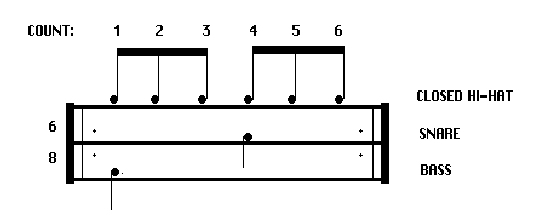
This dancebeat may tend to take on several technical names, depending on how it is written. It may be written and referred to as 6/8 or 12/8 (Blues). The 12/8 version includes two repetitions of the 6/8 pattern. This beat may also be written and referred to as an 8th triplet 2/4 or 8th triplet 4/4 (Blues). The 4/4 version includes two repetitions of the 2/4 pattern. No matter how it is written, the beat variations or permutations are exactly the same.
The 6/8 (or triplet 2/4) versions contain 4,896 possible variations like the examples below.
Variation Examples:
EXAMPLE #1:
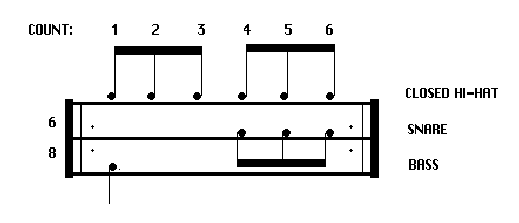
EXAMPLE #2:
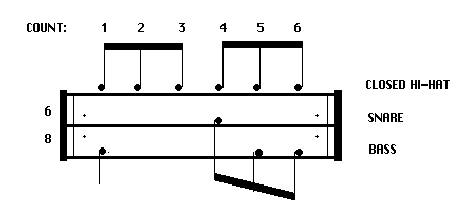
EXAMPLE #3:
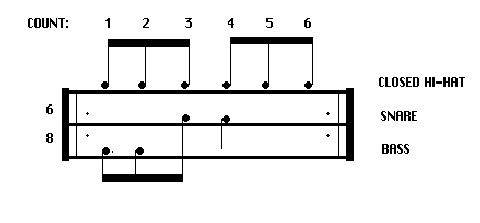
It is common to inject variations like the examples above, into a basic blues song-beat pattern in progress. In other words, try playing several repetitions of basic blues then play one repetition of a variation and return to the basic pattern.
Later on as you become more proficient with 8th rock syncopations, you will discover that it is easy to adapt many syncopations to these beat variations as well. There are approximately 16 million syncopated possibilities within every measure of a typical 12/8 Blues song. The good news is, only a relative handful of those rhythms are commonly used.
NOTE: as we inject a snare or bass drum note alone IN-BETWEEN any two steady flowing cymbal notes, it's called a syncopation (or sync.). EXAMPLE #4: Typical Blues Sync.
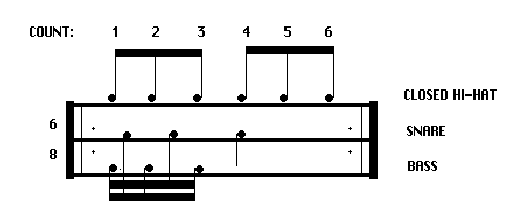
![]() Hear all the above blues variations in sequence.
Hear all the above blues variations in sequence.
LESSON PROJECT:
Practice these patterns with a 6/8 blues tune that suits your personal taste. Try several different songs that fall into this rhythm framework.
Listen to the drummer on the recording and try to imitate the patterns being played. You should get the hang of it quickly.
Play the blues beat VERY slowly and count 1, 2, 3, 4, 5, 6 as you repeat the beat pattern over and over. You will want to drop your fill on the numbers 4, 5, & 6, then return to the hi-hat as you begin the next beat repetition on the count of 1.
As an example, we will try a single stroke fill like the one below:
r=right
l=left
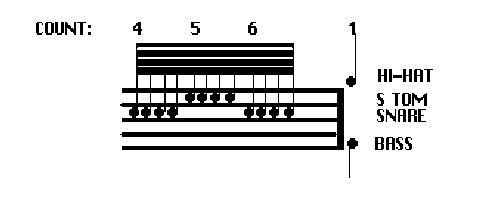
Begin on the snare (backbeat) of the beat pattern, play four notes (rlrl) on the snare, move up to the tom and play four notes (rlrl) then back to the snare with four (rlrl) more. Follow through to the hi-hat (or ride cymbal) after the third repetition of the roll. Connect with the cymbal and bass simultaneously on the resumption of the beat or count of one.
Practice the above fill until you can play it rapidly, then try other configurations and connect them to a blues beat in progress as shown below:

Note: In the example above the simultaneous cymbal and bass at the end of the fill *IS* the beginning of the next beat repetition, or count of one.
Though we have played a single stroke fill in the above example, the roll could be ANY roll, like triplets (lrl rlr lrl), paradiddles (lrllrlrrlrll), doubles (rrllrrllrrll). Rolls like flams, ruffs, press rolls and others may also be used in exactly the same way. Simply drop your chosen fill on the numbers 4, 5, and 6 and return to the beat on the count of one.
Remember to keep the beat pattern *VERY* slow and steady! The fills will seem extremely fast compared to the slow beat.
Later on, you may want to try playing 'whole measure' fills. To do 'whole measure' fills you would play six repetitions of the chosen roll. One for each count in the beat. Begin your fill on 'one' and end on 'one' of the next measure.
It helps to hear it and see it. If your computer system will allow you to play midi files and video, play the files and listen closely. Sometimes this is the easiest way to learn.
Video: For almost all handheld devices and other browsers.
QUESTION: Do you know the answer to the following . . .?
What is the difference between 6/8, 12/8, 8th triplet 2/4, and 8th
triplet 4/4?
This lesson will attempt to explain it.
 Back to the lesson menu:
Back to the lesson menu:
![]() Copyright Bill Powelson 1965-1994-2008-2014 @ all rights reserved.
Copyright Bill Powelson 1965-1994-2008-2014 @ all rights reserved.
![]()
![]()
![]() Drum Solo Video: Click to 'LEARN'
Drum Solo Video: Click to 'LEARN'
Watch and Learn Now! PLAY Great Drum Solos within hours (not years).
NEW 'Subliminal Method' teaches drum solo techniques PAINLESSLY!
Master rudiments 'NATURALLY' without boring regimentation or serious discipline.
Listen, watch and PLAY your way to awesome drum solos (and polished rudiments) BY SIMPLY HAVING FUN. . . . It works, folks!
Don't be a skeptic until you at least try it first.
![]()
![]()
7 EZ lessons to Rhythm-Guru Status.
E-mail support: (til I croak).
EZ Downloads to CDs/Flashdrives
Special Secret Seeds of Rhythm.
Breaking-into Career Drumming $$
Musical Time - Finite to Infinity: Learn to easily jam and play music comfortably within any odd or even time signature. This material isn't currently taught in music-theory classes, yet it is simple enough for grade-school students. Discover more than 18 quintillion unique and different (modern music) song-beat structures.
Discover the (lost) 500 year-old enigmatic secrets hidden within the current time-signature system. Seven short mesmerizing and easy-to-follow lessons will lead you quickly and easily towards (musical-time) guru status. You will learn to visualize (read, write or feel) the existence More . . .
This very informative little booklet will amaze you with hundreds of valuable tips and insider secrets!
HOW TO: Purchase old/used drumsets for pennies and resell them for decent profits. How to find the bargains, create thousands of attention getting finishes at low cost. Brighten old cymbals and learn to rebuild old drumsets from the gound up.